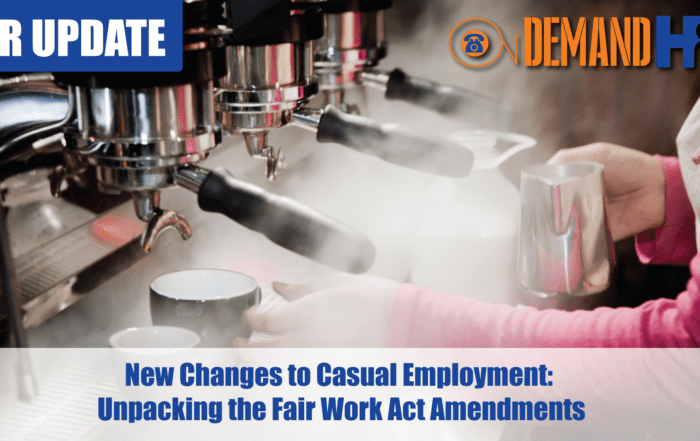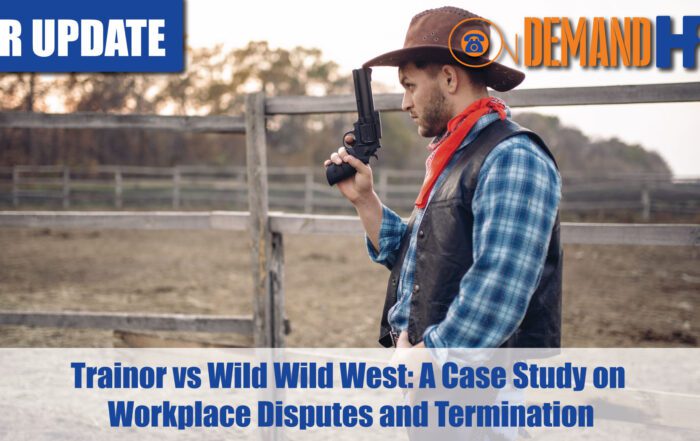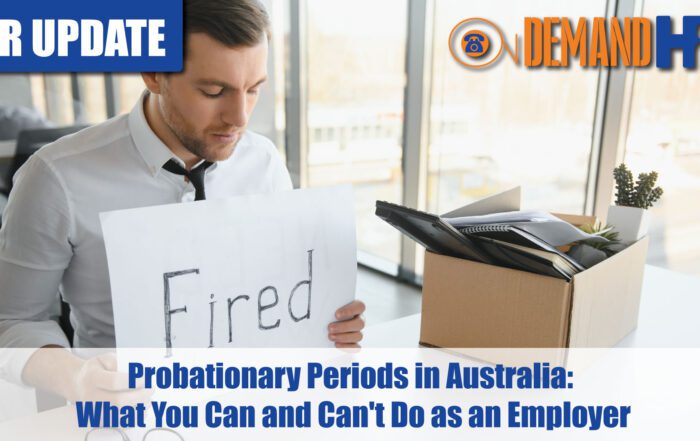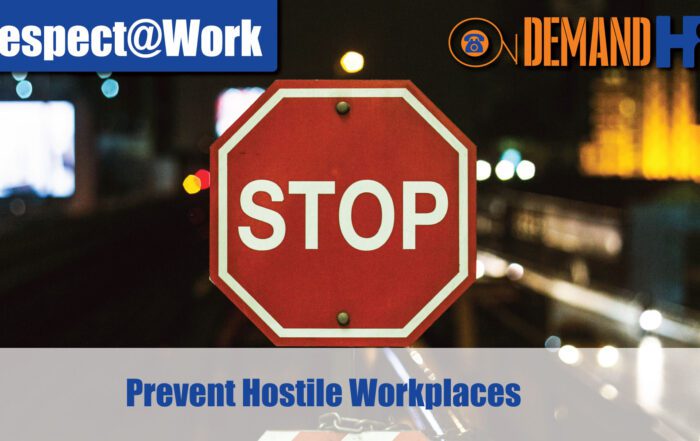Proposed Changes To Casual Employment
Many businesses were concerned with reulings from the Fair Work Commission regarding paid entitlements for casual workers such as annual leave and sick leave. What does this mean for your business? And what proposed legislation is currently before parliament to prevent widespread blow outs in wages costs across Australia?
Please see below for a full transcript of the video.
Share the HR or workplace relations challenge facing your business and one of our experienced consultants will be in touch within 24 hours with a strategic action plan or discover the best strategy yourself by accessing out free online training library.
Transcript
0:00
And I’m going to start with some of the proposed, I guess, IR reforms that are currently being put forward by the government. So the first thing that the government is looking at at the moment is in respect to casual employment.
So you may recall in the last sort of couple of years, discussions around Rossato versus Workpac, and Skene versus Workpac. So those were two key cases were essentially casuals who were employed on a casual basis, tried to effectively double dip. So they received casual loadings during their employment, and then tried to double dip for getting paid annual leave entitlements upon the termination of your employment by way of commencing various different cases.
Now, in those two situations, both employees were found to have had valid cases for annual leave to be paid, and that that’s given that’s given well, that sort of sent shock shockwaves through the Workplace Relations system, and a lot of a lot of organizations, a lot of lawyers were talking about, well, what is the impact of this? And how much might this flow on to other types of casual employment? I Yes, sir? I don’t have them exactly offhand. I remember the Skene, one being probably around about I think it was 2018. I think the Skene one and I think the Rossato one was last year, wasn’t it, Andrew? because we presented on that last year? Skene was good two years earlier. Yeah, then then Rossato I think 2018. And the Rossato one was last year, Skene was definitely first, both on a very similar principle. Both were employees of Workpac. For those who sort of were following the case, what happened in these particular cases is these were casuals, who got rosters long, long time in advance, you know, 12 months in advance, and we’re sort of had fly in fly out arrangements, there was penalties for not being available for shifts. So it wasn’t the true sense of casual employment, as you would see in, you know, various different other industries like hospitality or other, even even if they’re regular types of casual employment. This, this was a kind of a, you know, if you like casual employment on steroids, because it was it really was very, very similar to full time employment the way these were operating.
I would say, I would say this, that these two cases are probably the most extreme form of casual employment, in the sense that the rosters were so far in advance, there was there was absolutely almost no variation in the hours that they worked, it was almost exactly the same roster from roster cycle to roster cycle. So I would say that other forms of casual employment are less than this type of casual employment, to varying different degrees.
I mean, you’ve got the true essence of what a casual employee is supposed to be, it is supposed to be someone who kind of works on an irregular ad hoc basis as is required. Now, that’s the other extreme, if you like, is the casual who’s just gets the call every now and then. And the ones in between are you kind of typical restaurants, cafes, where Yeah, they might work different shifts every week, but it’s 15 hours, one week, 20 hours next week, 20 hours next week. So it’s, it’s regular. And you know, some of them are very systematic in the way that they operate. So I think there’s varying degrees of casual employment.
I think what the what the intention is of this reform, is to give business confidence in engaging casual employees going forward, the last thing the government wants is a situation where this is going to have a flow on effect to other forms of casual employment. And really, aside from these cases, there hasn’t been much else. So there was an expectation that there was going to be an avalanche of other casuals claiming these things. And that hasn’t really materialized. Back in 2018 when the Skene case happened, you know, even we were saying, Well, you know, how far is this gonna go?
So the government is what they’re trying to do is really close this loophole, if you like, because we think about it in in logical terms, if an employee is receiving a casual loading, and if that casual loading is supposed to compensate for annual leave long service, all the benefits no long service, the annual leave personal leave, you know, regular employment, all the benefits of permanent employment, well, then why should that person be able to then double dip and get, you know, annual leave paid to them again? So the intention of this is to close that loop.
And there’s three key things that I think will be looked at in this in this legislation. Bearing in mind this is nothing’s been passed yet, but they’re going to create some change around the definition of casuals that there is an offer and acceptance of work with no firm advanced commitment, exactly what that looks like is still yet to be kind of determined in the detail. But employers can also offset casual loadings paid against future claims for entitlements such as sick leave and annual leave. And, and and that’s actually something we’ve already done with our clients. We’ve already put provisions into casual employment agreements, which have said exactly that we’ve actually done this nearly a year ago. In response to this Rossato case that we we essentially are saying to casuals that if you’re paid or casual loading if you want to make a claim for permanent settlements later on down the track, then we’ll offset it. And in most cases, the casual loading is actually more than the claim for permanent entitlements.
If you were if you do the math for people who are obviously people around the room love their math, I would imagine you’re talking roughly the cost of entitlements being around about 15%, when most casual loadings are 25, so gives you an idea of what the comparison is.
The other change that we’re going to see is, some awards have six months, you’ve got to advise a casual, they can convert some awards, say 12 months. Now, bear in mind, don’t be, don’t be misunderstood on this particular issue, there is no obligation to convert at 12 months, for any casual. The obligation is for the employer to advise that they have the ability to convert, but whether the employee wants to convert or not, is a choice for them. And the quite frankly, the easiest way to get out of converting anyone in this regard, is simply to say that if you do convert, you won’t be receiving casual loadings anymore. And that’s and that’s you’re not required to keep paying the same casual rate for permanent employment.
So again, what we typically do in dealing with these issues, we deal with it upfront, in the employment contract will say, you have the ability to convert after either six months or 12 months, what they’re proposing in this legislation that will be 12 months across the board. And then that that kind of notification requirements met up front in the employment contract. And but ultimately, what we’re going to see is that employees are not stupid, they’re going to look at this and go, well am I better off getting the 25% or am I better off getting, you know, the annual leave and personal leave, obviously I use my annual leave every year but will I even use all my 10 days of personal leave, I might not.
So in often, something unions have pushed very, very hard the unions have pushed this notion that Oh well, you know, conversion, it’s got to be there because people want to convert to permanent employment. And that’s all people want. And that’s and that’s actually very out of touch, I think with reality, the reality is a lot of people who work in casual employment, like being in casual employment, like the casual loadings, and they don’t want to take permanent position for 25%, less pay.
So that’s what this is going to deal with, there’s also going to be a provision of a casual employment statement to new employees to be prepared by the Fair Work Commission, very similar to the Fair Work Information Statement, who I’m not sure if those around the room are familiar with that that but one of the obligations when you engage a new employee is to provide a Fair Work Information Statement. So this casual employment statement will be similar to that.
So those are some of the changes that we’re going to see coming in casual employment, whether this is passed or not remains to be seen some of the commentary from the Labor Party on this already is trying to use, you know, make comments about this being worse than Work Choices, which was the old legislation back in 2007. Whilst that, you know, probably couldn’t be further from the truth. There will obviously be a lot of politicking in all of this and how this how this works. So stay tuned on that.
But those are some of the proposals around casual employment that we will see in the period ahead. In terms of casuals, this is this is really focused around I guess casuals who work regularly. And and obviously, that requirement, not requirement, the obligation to notify that employees can convert to full time and part time employment. But in the 11 years that we’ve been in, I’ve been consulting at On Demand HR, I can tell you that the amount of times that casuals have converted from casual employment to full time or part time employment, I can tell you it’s on one hand, it’s not it’s not very many at all. So and that’s because as most people just understand that the money 25% is worth more than the entitlements and the benefits of permanent employment. So that’s certainly that’s how it’s perceived anyway.
Casuals after 12 months, or after six months in a business of 15 or more employees have access to unfair dismissal relief anyway. So So this notion that you know, it’s easier to terminate a casual than it is to terminate a permanent Well, it’s not really as soon as a casual becomes regular and systematic. There’s there’s really not a lot of difference. Yes, you could argue in some restructuring or redundancy arrangements, it is easy to end the employment of casuals than permanents and that is true to an extent. But in terms of the standard casual employee who’s not performing versus your standard, permanent employee who’s not performing, there’s really not a lot of difference in how you performance manage a person like that out of the organization. So they’ve got that protection for unfair dismissal. They accrue long service leave in most states. So I think might even be all states. So you know, they are really only missing out on that annual leave, personal leave. You would be missing out on things like notice and redundancy pay and things like that, but, you know, there’s a lot of those things with casual employees exactly as you right they they’re going to continue working. They’re gonna continue getting paid to continue receiving their 25% loadings.






